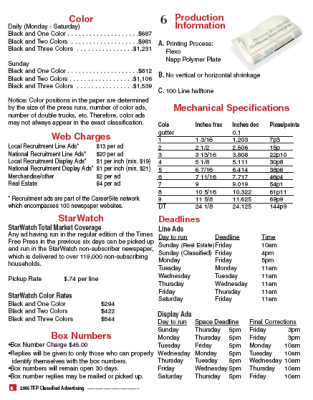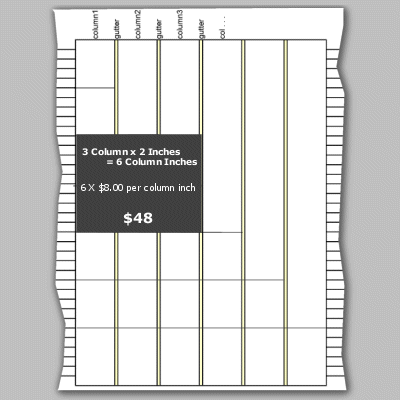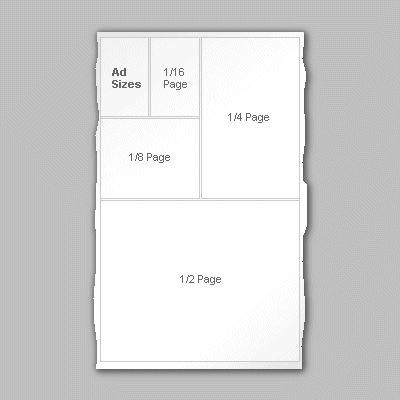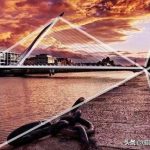Understanding Advertising Rate Cards
By Shari Waters, About.com Guide
1.What is an Advertising Rate Card?
A rate card is a document provided by a newspaper or other print publication featuring the organization’s rate for advertising. It may also detail any deadlines, demographics, policies, additional fees and artwork requirements. The smaller the publication, the less information that may be available in the rate card.
Some larger newspapers may have a rate card for a particular kind of advertisement. They may have their rates broken down by classified ads, retail advertising and even national ad rates.
Rate cards help the retailer understand what types of ad sizes, discounts and other advertising the publication has to offer. When choosing a newspaper or print media, you can use rate cards to compare ad rates based on circulation before you buy advertising space.
Before placing an ad, be sure you understand the terms and conditions of advertising with the publication. In many cases where there may be a conflict between the insertion order and the rate card, the rate card will be the deciding factor. This does not mean the prices on the rate card are fixed. Most retailers will find the paper’s sales rep will offer special rates for first time advertisers or other discounts.
If you’re interested in advertising within a particular publication, check their website or call the office and ask for a copy of their current rate card. Many newspapers and magazines have their rate cards available online in a PDF format.
2.Readership vs. Circulation
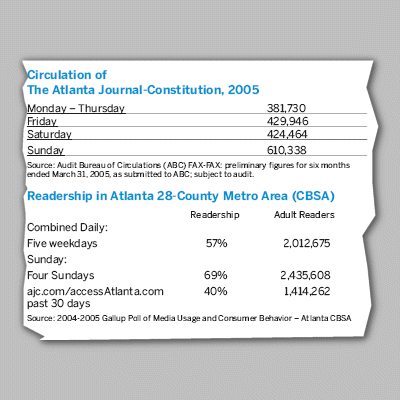
Atlanta Journal Constitution Ad Rate Card
On most rate cards, the organization will show its coverage area, demographics and circulation. Some publications also list their readership. Circulation is the number of newspapers that are printed and distributed each day. Readership reflects the actual number of people who read those newspapers.
3.ROP – Full Run of Paper
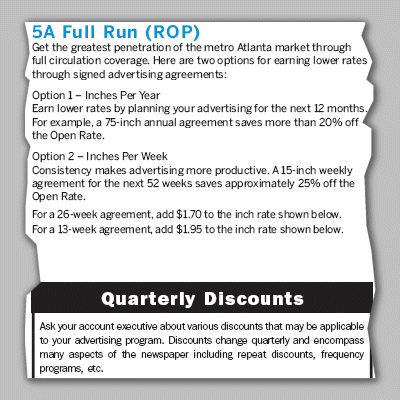
Atlanta Journal Constitution Rate Card Sample
Run of Paper (ROP) usually means your advertisement can appear in any location within the newspaper. With some papers, display ads may not appear in the classified section. If you plan to advertise infrequently during the year you may choose to purchase your space at the open rate. If you plan to advertise more often, you will want to sign a contract.
4.Frequency Discounts On Display Ad Rates
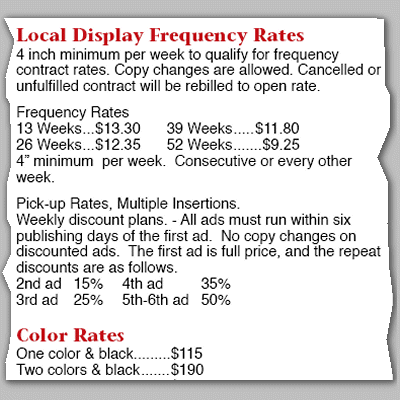
Red Bluff Daily News Rate Card
A frequency discount is a contract rate offering one of the best discounts for display ads. The best committment is usually running a minimum size ad each and every week for a 52-week period. Some newspapers also have shorter periods such as 13 and 26-week contracts.
5.Open Rates and Bulk Space Contracts
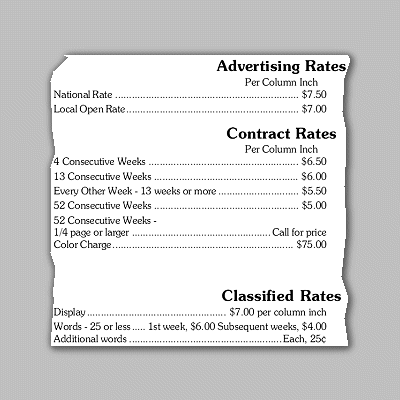
The Jefferson Reporter Rate Card Contract Rates
Publishers offer an open rate without discounts. This is the rate that you would be charged for running a single, one-time advertisement. This is sometimes referred to as the non-contract rate.
A discount offered for an advertising commitment to a certain number of ads within a specified time period, is called a Bulk Space Contract. For example, if you agree to place 300 inches of advertising in the newspaper within the next year, your per inch rate would be lower than if you ran one ad one time that year.
6.Display Advertising Mechanical Measurements
There may be some variation in measuring ad space in different publications. Here are the definitions of column inch, standard advertising unit and pica.
Column Inch: Display advertising’s primary space measurement. This is generally one column wide by one inch deep. it may vary by publication.
Standard Advertising Unit (SAU): Ad size formats that may be accepted in different daily newspapers. This standard was created to make it easier for a large advertiser to place the same ad in many different newspapers without adjusting the ad to different column specifications.
Pica: A typographic unit of measurement: 12 points = 1 pica or 1/6” (0.166”), and 6 picas = 1” (or 0.996”).
7.Calculating Display Ad Rates Per Column Inch
When calculating the rates for a display ad, determine the number of column inches in an ad. Multiply the number of columns wide by the number of inches deep.
__# of columns x __# vertical inches x __rate per inch
= ___ total ad price
In our example, this business card size ad in our diagram is 3 columns by 2 inches (6 total column inches). If the newspaper’s columns measure 1 3/8″ then we can assume this ad is 3 3/8″ wide by 2″ deep. The open rate is $8.00 per column inch, which is 6 column inches x $8.00 for an ad total of $48.
8.Advertising Page Layout With Ad Sizes
Not all rate cards use per column inch to calculate advertising rates. Many specialty newspapers and magazines offer certain rates based on pre-calculated ad sizes. Here are a few typical ad sizes.
http://retail.about.com/od/marketingsalespromotion/ss/ad_rate_card.htm
Effective Newspaper Advertisement Types
The Display Ad
By Shari Waters, About.com Guide
Effective Ad Types
People get their news from so many sources these days that newspapers aren’t as effective as they once were. This doesn’t mean your newspaper ad won’t be effective, but it does mean you need to plan your print ads more strategically. Some types of ads will be more effective than others. It will depend on your target audience, the type of products you offer and where the ad is seen.
Newspapers generally feature two types of ads. First, there is the classified ad or text ad, and then you have retail advertising or display ads. The display ad may be all text or include images and can be found throughout the publication. All of the following types of newspaper ads refer to display ads.
Business Card Ad – This type of ad basically says who and where you are, and what you sell. It may include your logo. Short and sweet, that’s it. This could be a nice small ad that you run year round.
Coupon Ad – These are great for sales promotions to bring new customers to the store. By offering a certain dollar or percent amount off your merchandise, the coupon offer is also one of the easiest ads to track the effectiveness.
Sale Ad – Instead of offering a discount to a particular customer like the Coupon Ad, the Sale Ad invites the public into their store to receive a discount on a product, department or the entire store. Most retailers limit the extent of their newspaper advertising to the ad featuring a clearance or other markdown sale.
Spotlight Ad – This type of newspaper ad focuses the attention to a particular product, product line, staff member or customer of your business. This looks good as a larger display ad run just a few times each year.
Informational Ad – This ad could be written as a Q&A ad offering your professional advice on a topic your store covers. It could also be written in a journalistic style making it read like an article instead of an advertisement.
http://retail.about.com/od/marketingsalespromotion/a/effective_ads.htm

